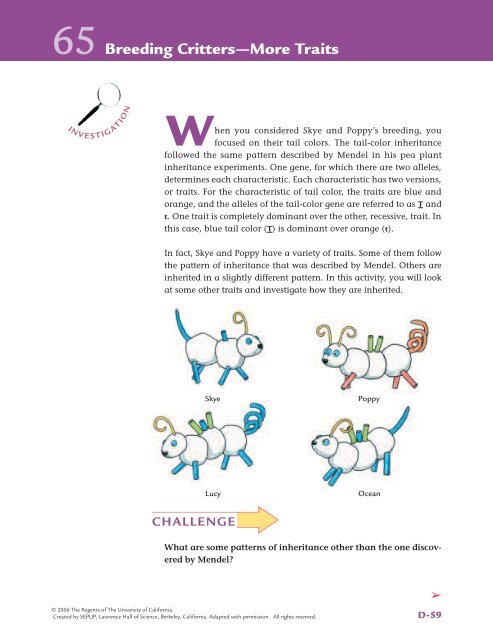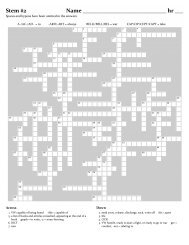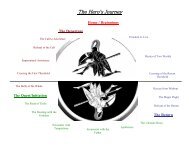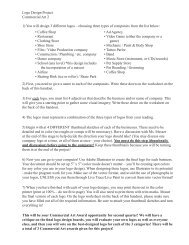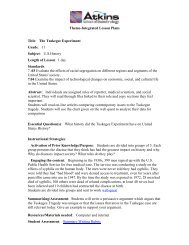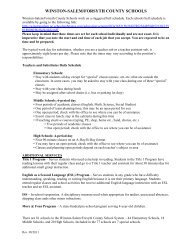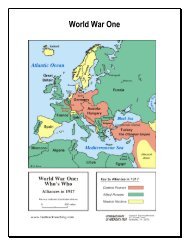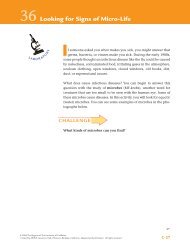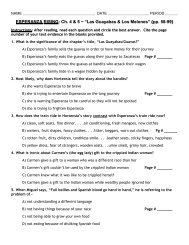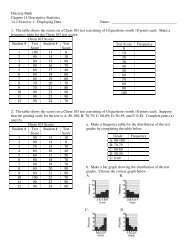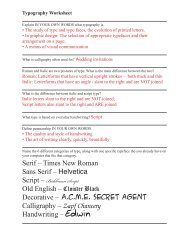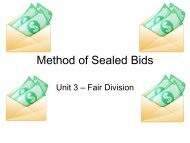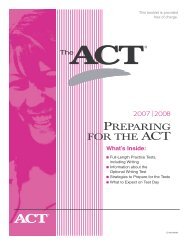Act 65
Act 65
Act 65
You also want an ePaper? Increase the reach of your titles
YUMPU automatically turns print PDFs into web optimized ePapers that Google loves.
<strong>65</strong> Breeding Critters—More Traits<br />
I N V E S T<br />
I O N<br />
I G AT<br />
When you considered Skye and Poppy’s breeding, you<br />
focused on their tail colors. The tail-color inheritance<br />
followed the same pattern described by Mendel in his pea plant<br />
inheritance experiments. One gene, for which there are two alleles,<br />
determines each characteristic. Each characteristic has two versions,<br />
or traits. For the characteristic of tail color, the traits are blue and<br />
orange, and the alleles of the tail-color gene are referred to as T and<br />
t. One trait is completely dominant over the other, recessive, trait. In<br />
this case, blue tail color (T) is dominant over orange (t).<br />
In fact, Skye and Poppy have a variety of traits. Some of them follow<br />
the pattern of inheritance that was described by Mendel. Others are<br />
inherited in a slightly different pattern. In this activity, you will look<br />
at some other traits and investigate how they are inherited.<br />
Skye<br />
Poppy<br />
Lucy<br />
Ocean<br />
CHALLENGE<br />
What are some patterns of inheritance other than the one discovered<br />
by Mendel<br />
© 2006 The Regents of The University of California.<br />
Created by SEPUP, Lawrence Hall of Science, Berkeley, California. Adapted with permission. All rights reserved.<br />
➢<br />
D-59
<strong>Act</strong>ivity <strong>65</strong> • Breeding Critters—More Traits<br />
MATERIALS<br />
For each group of four students<br />
colored pencils<br />
1 plastic cup<br />
For each pair of students<br />
1 Student Sheet <strong>65</strong>.1, “Critter Breeding Worksheet”<br />
2 pennies<br />
THE MODEL<br />
The table below shows Skye’s and Poppy’s traits. It also shows the<br />
traits of all their offspring. In this activity, you will look at more traits<br />
in the Generation Three offspring, which are produced when Generation<br />
Two offspring mate with each other. Lucy, a female, and Ocean,<br />
a male, are the Generation Two critters who will mate.<br />
Table 1: Generation One and Generation Two Traits<br />
Characteristic Skye Poppy 100 Offspring<br />
(such as Lucy and Ocean)<br />
Body segments (number) 2 3 3<br />
Leg color blue red blue<br />
Eyes (number) 2 3 2<br />
Nose length short long medium<br />
Tail color blue orange blue<br />
Tail style straight curly 48 curly, 52 straight<br />
Antennas (number) 1 2 2<br />
Spikes (color and number) 1 short blue 2 long green 1 short blue + 2 long green<br />
Sex male female 53 female, 47 male<br />
D-60<br />
© 2006 The Regents of The University of California.<br />
Created by SEPUP, Lawrence Hall of Science, Berkeley, California. Adapted with permission. All rights reserved.
Breeding Critters—More Traits • <strong>Act</strong>ivity <strong>65</strong><br />
Table 2: Critter Code<br />
PROCEDURE<br />
1. Work in pairs. Place Student Sheet <strong>65</strong>.1, “Critter Breeding Worksheet,”<br />
between you and your partner. The person sitting on the left<br />
side will toss a penny for Ocean, while the person on the right will<br />
toss a penny for Lucy.<br />
2. For each toss, each partner should:<br />
Characteristic Alleles Trait<br />
• Hold a penny in cupped hands.<br />
Body segments BB 3<br />
(number) Bb 3<br />
bb 2<br />
Leg color LL blue<br />
Ll blue<br />
ll red<br />
Eyes (number) EE 2<br />
Ee 2<br />
ee 3<br />
Nose length NN long<br />
Nn medium<br />
nn short<br />
Tail color TT blue<br />
Tt blue<br />
tt orange<br />
Tail style SS curly<br />
Ss *curly or straight<br />
ss straight<br />
Antennas AA 2<br />
(number) Aa 2<br />
aa 1<br />
Spikes (color GG 1 short blue<br />
and number) HH 2 long green<br />
GH 1 short blue +<br />
2 long green<br />
*To find out if an Ss critter’s tail is curly or straight, toss a coin.<br />
If it shows heads, the critter’s diet contains “crittric” acid, and<br />
it develops a curly tail. If the coin shows tails, the critter’s diet<br />
does not contain “crittric” acid, and it develops a straight tail.<br />
© 2006 The Regents of The University of California.<br />
Created by SEPUP, Lawrence Hall of Science, Berkeley, California. Adapted with permission. All rights reserved.<br />
• Shake it to the count of ten.<br />
• Allow it to drop from a height of about<br />
20–40 cm (8–16 inches) onto the desk.<br />
3. The partner on the left tosses a penny to<br />
determine which allele for number of<br />
body segments Ocean gives to his offspring.<br />
If the penny shows heads, write B<br />
in the column titled “From Ocean“ on Student<br />
Sheet <strong>65</strong>.1. If the penny shows tails,<br />
write b. The other partner tosses a penny<br />
to determine the allele which Lucy gives.<br />
Write the letter for that allele in the column<br />
titled “From Lucy.”<br />
4. Determine the offspring’s trait for number<br />
of body segments. Look at the alleles you<br />
wrote under ”From Ocean“ and “From<br />
Lucy.” Compare these alleles with the Critter<br />
Code in Table 2 (or with the information<br />
in the first column of Student Sheet <strong>65</strong>.1).<br />
Then write the appropriate trait in the next<br />
column. For example, if you wrote Bb for<br />
the alleles, the trait is ”3 segments.”<br />
5. Continue tossing coins and filling in Student<br />
Sheet <strong>65</strong>.1 until you have completed<br />
the table. Use the Critter Code to determine<br />
the trait for each characteristic,<br />
based on the allele combination in the offspring.<br />
Note the special instructions for<br />
tail style.<br />
➢<br />
D-61
<strong>Act</strong>ivity <strong>65</strong> • Breeding Critters—More Traits<br />
6. Find out if your critter is male or female by determining its sex<br />
chromosomes as follows:<br />
a. Ocean is an XY male. The partner representing Ocean tosses a<br />
penny. If it shows heads, Ocean donates an X chromosome to<br />
the offspring. If the penny shows tails, Ocean donates a Y chromosome<br />
to the offspring.<br />
b. Lucy is an XX female. The partner representing Lucy does not<br />
need to toss a penny. Lucy can donate only an X chromosome<br />
to the offspring.<br />
Write the sex (male or female) of the offspring in the appropriate space.<br />
7. Use the following materials provided by your teacher to make your<br />
critter.<br />
Table 3: Critter Parts<br />
Body segments<br />
Heads<br />
Legs<br />
Eyes<br />
Nose<br />
Tail<br />
Antennas<br />
Spikes<br />
Large foam balls connected by toothpicks<br />
Small foam balls<br />
Pieces of red or blue drinking straws<br />
Blue thumbtacks<br />
Brass fastener, adjust length<br />
Blue or orange pipe cleaner<br />
Yellow paper clip<br />
Pieces of blue or green drinking straws<br />
8. Draw your critter and color in the body parts.<br />
D-62<br />
© 2006 The Regents of The University of California.<br />
Created by SEPUP, Lawrence Hall of Science, Berkeley, California. Adapted with permission. All rights reserved.
Breeding Critters—More Traits • <strong>Act</strong>ivity <strong>65</strong><br />
ANALYSIS<br />
1. Look at the other critters made by your classmates. They are all<br />
siblings (brothers and sisters). What are their similarities and differences<br />
2. Which characteristics show a simple dominant/recessive pattern<br />
like tail color List them in a table and indicate which version is<br />
dominant and which is recessive for each trait.<br />
Hint: Look at Table 1 to see which traits have this pattern.<br />
Some traits do not show a simple dominant vs. recessive pattern. Look at<br />
Table 1 to help you answer Questions 3–5.<br />
3. For which characteristic do some offspring have traits in between<br />
Skye’s and Poppy’s traits Explain. (For example, in some plants,<br />
a cross between a red- and white-flowered plant will give pinkflowered<br />
offspring. This is called incomplete dominance.)<br />
4. For which characteristic do some offspring have both Skye’s and<br />
Poppy’s traits Explain. (For example, in humans, a person with<br />
type A blood and a person with type B blood can have a child with<br />
type AB blood. This is called co-dominance, as both traits appear<br />
in the offspring.)<br />
5. Which critter trait is affected by an environmental factor, such as<br />
light, temperature, or diet Explain.<br />
6. Consider the pattern for sex determination.<br />
a. How is a critter’s sex determined<br />
b. Whose genetic contribution—Ocean’s or Lucy’s—determines<br />
the sex of the offspring<br />
7. Who does your critter most look like—Skye, Poppy, Ocean, or Lucy<br />
On which traits did you base your choice<br />
8. Draw a critter with all recessive traits. Assume the recessive trait for<br />
spikes is no spikes.<br />
EXTENSION<br />
Use a software program called GenScope to investigate genetics. Go to<br />
the SALI page of the SEPUP website for instructions.<br />
© 2006 The Regents of The University of California.<br />
Created by SEPUP, Lawrence Hall of Science, Berkeley, California. Adapted with permission. All rights reserved.<br />
D-63


